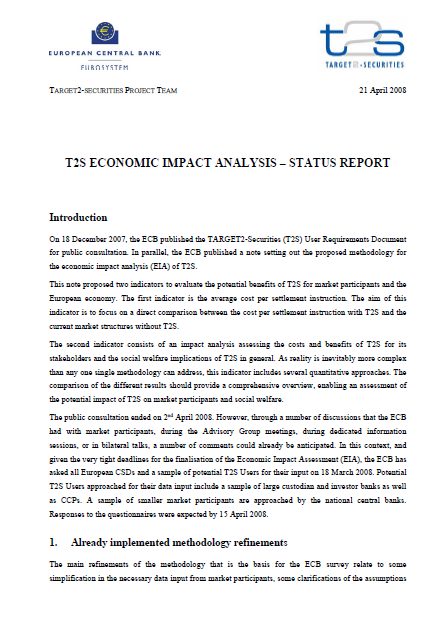 TARGET2-SECURITIES PROJECT TEAM
TARGET2-SECURITIES PROJECT TEAM
- 7 pgaes
- Restricted
- April 21, 2008
Introduction
On 18 December 2007, the ECB published the TARGET2-Securities (T2S) User Requirements Document for public consultation. In parallel, the ECB published a note setting out the proposed methodology for the economic impact analysis (EIA) of T2S.
This note proposed two indicators to evaluate the potential benefits of T2S for market participants and the European economy. The first indicator is the average cost per settlement instruction. The aim of this indicator is to focus on a direct comparison between the cost per settlement instruction with T2S and the current market structures without T2S.
The second indicator consists of an impact analysis assessing the costs and benefits of T2S for its stakeholders and the social welfare implications of T2S in general. As reality is inevitably more complex than any one single methodology can address, this indicator includes several quantitative approaches. The comparison of the different results should provide a comprehensive overview, enabling an assessment of the potential impact of T2S on market participants and social welfare.
The public consultation ended on 2nd April 2008. However, through a number of discussions that the ECB
had with market participants, during the Advisory Group meetings, during dedicated information
sessions, or in bilateral talks, a number of comments could already be anticipated. In this context, and
given the very tight deadlines for the finalisation of the Economic Impact Assessment (EIA), the ECB has
asked all European CSDs and a sample of potential T2S Users for their input on 18 March 2008. Potential
T2S Users approached for their data input include a sample of large custodian and investor banks as well
as CCPs. A sample of smaller market participants are approached by the national central banks.Responses to the questionnaires were expected by 15 April 2008.
1. Already implemented methodology refinements
The main refinements of the methodology that is the basis for the ECB survey relate to some simplification in the necessary data input from market participants, some clarifications of the assumptions in the baseline scenario that further minimise the estimated benefits from T2S and two additional scenarios. The baseline scenario in the questionnaires for the T2S EIA uses the following assumptions:
• The user requirements of T2S are those which are under public consultation.
• All settlement instructions in central bank money in euro in the euro area CSDs are processed in
T2S.
• All data requested in the questionnaire (fees, traffic…) relate to 2007: in order to avoid making
controversial assumptions about future fees and traffic, the actual figures of 2007 are compared
with estimated figures for 2007 in case T2S had existed. The EIA methodology then applies a
common conservative growth factor to the traffic figures to arrive at estimated 2013 traffic which
is then held constant.
• Complete adjustment to T2S: CSDs stop investing in the settlement function as soon as the
Governing Council decides to implement T2S (assumption: July 2008), or invest only in projects
of relatively small size which can be recovered before T2S opens (assumption: July 2013).
Moreover, they “reshape” completely their infrastructure as soon as T2S opens, closing all parts
which are no longer needed with T2S; this means in particular the CSDs do not replicate in their
infrastructure processes and data which they can “pull” or get per “push-mode” at any moment
from T2S. It is also assumed in this hypothesis that they do not maintain national specificities and
that they do not offer matching facilities.
• CSDs offer both direct and indirect connectivity.
• Market participants continue with their present business relationships in 2007 and do not take into
account new opportunities offered by T2S. For example, it is assumed that no new link is opened
between CSDs and that no customer decides to by-pass its present direct custodian (if any).
Although it is expected that T2S will provide incentives to establish new business relationships in
reality, they are not taken into account in the baseline scenario.
• Similarly, the only harmonisation benefits taken into account in the EIA are those which come
directly from the User Requirements (collateral and back-office benefits). However, it is clear
that T2S provides a strong incentive to harmonise in other fields, in corporate events in particular.
Because it is very difficult to evaluate benefits beyond the current version of the user
requirements, and because it would be very difficult to estimate the share of these benefits which
relates to T2S, these are not counted in this – conservative – approach.In addition to the baseline scenario that focuses on settlement in euro in the euro area CSDs as foreseen in
the methodology note from 18 December 2007, the revised methodology includes a scenario where T2S
settles also in other currencies of the European Union with a focus on four markets (CHF, DKK, GBP,
SEK). A second additional scenario assumes that CSDs do not completely adjust to T2S but rather keep
their current investment schedule, or follow a similar pattern as in the previous years. Moreover, they
“reshape” to the minimum extent to T2S, keeping their internal processes as much as possible and
therefore replicate T2S data in their systems. A third additional scenario – already foreseen in the
